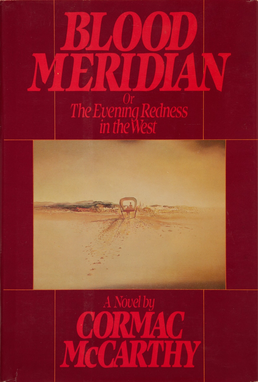Part 5
byPart 5 of Blood Meridian takes readers through a haunting, desolate landscape, where the aftermath of a brutal battle unfolds before the eyes of the lone survivor. This man, bloodied and covered in the remnants of violence, rises from the wreckage of death, where the land is littered with fallen bodies—both human and animal. As he surveys the area, the soft glow of distant fires and the eerie, distant sound of chanting fill the air, hinting at the persistence of violence in this unforgiving world. Moving southward, his steps are filled with uncertainty, yet his determination to survive pushes him forward as he navigates the harsh, rocky terrain that stretches endlessly before him, always looking over his shoulder, wondering what dangers lie ahead.
As dawn breaks, the survivor encounters another figure—Sproule, another man marked by the violence of the previous day’s encounter. Sproule, gravely wounded and soaked in blood, recounts his escape from the massacre, and the two men exchange stories of horror and survival. Together, they conclude that the attackers, whose savagery seems limitless, belong to an unknown tribe, and a shared unease settles between them as they realize that their lives hang by a thread in a world that offers no mercy. They speak of their fears, and as they prepare to continue their journey, they find themselves bound by a shared understanding of the brutality they’ve faced, uncertain about what awaits them on the path ahead.
Seeking shelter from the blazing sun, the two men pause, their bodies weary from their harrowing journey, before they continue down a war trail that leads them to an abandoned village. Upon arriving, the village stands as a grim reminder of the devastation of war, its streets littered with the remains of what once was a thriving community. The gruesome sight of hanged children, the bodies of dead animals, and the broken homes paint a picture of utter desolation, forcing the men to confront the harshness of their surroundings. There is no sign of life—just death and silence—marking the end of the village’s existence, leaving the men with the chilling realization that they are surrounded by nothing but ruins and the aftermath of violence.
As Sproule’s health deteriorates, their sense of urgency grows, and the two men wrestle with the decision of whether to continue their journey or return to Texas. Sproule’s worsening condition, coupled with his constant coughing, creates a dire situation, one that forces the men to question if they should risk it all in the hope of survival. Despite Sproule’s fragile state, the Kid decides to venture deeper into the village to search for food and supplies, hoping to find something that could ease their burdens. The village, which once teemed with life, now serves as a haunting symbol of the devastation that war and conflict leave behind, and the Kid’s desperate search for something—anything—becomes a fight for hope in a place devoid of it.
Eventually, the Kid finds some supplies in a nearby home and returns to Sproule, only to find that the man has gone missing. Frantically searching, he discovers Sproule in a church, but the sight that greets him there is even more disturbing than he could have imagined. The church, once a place of refuge, now holds the remains of yet more victims, their bodies left to rot, and the gruesome scene further underscores the violent reality they are trapped in. The presence of death everywhere forces the Kid to confront the fragility of life in this brutal world, and the men are left with no choice but to leave the church and face the harsh reality outside, knowing that their survival depends on their ability to continue moving forward.
As they set out into the night, the weight of their situation begins to truly sink in. The landscape around them, filled with the remains of those who have fallen, offers no solace, and the darkness is not a comfort but a reminder of the dangers lurking at every turn. The constant presence of death, the never-ending struggle for survival, and the overwhelming sense of despair that surrounds them serve as an unrelenting force shaping their journey. Each step they take further into the desolate night brings them closer to the grim truth of their existence: they are alone, surrounded by a world that is hostile, indifferent, and constantly shifting between moments of terror and fleeting hope. The haunting images of the people they have encountered and the violence they’ve witnessed will follow them, shaping every decision they make as they try to survive in a world where mercy is a distant memory.

